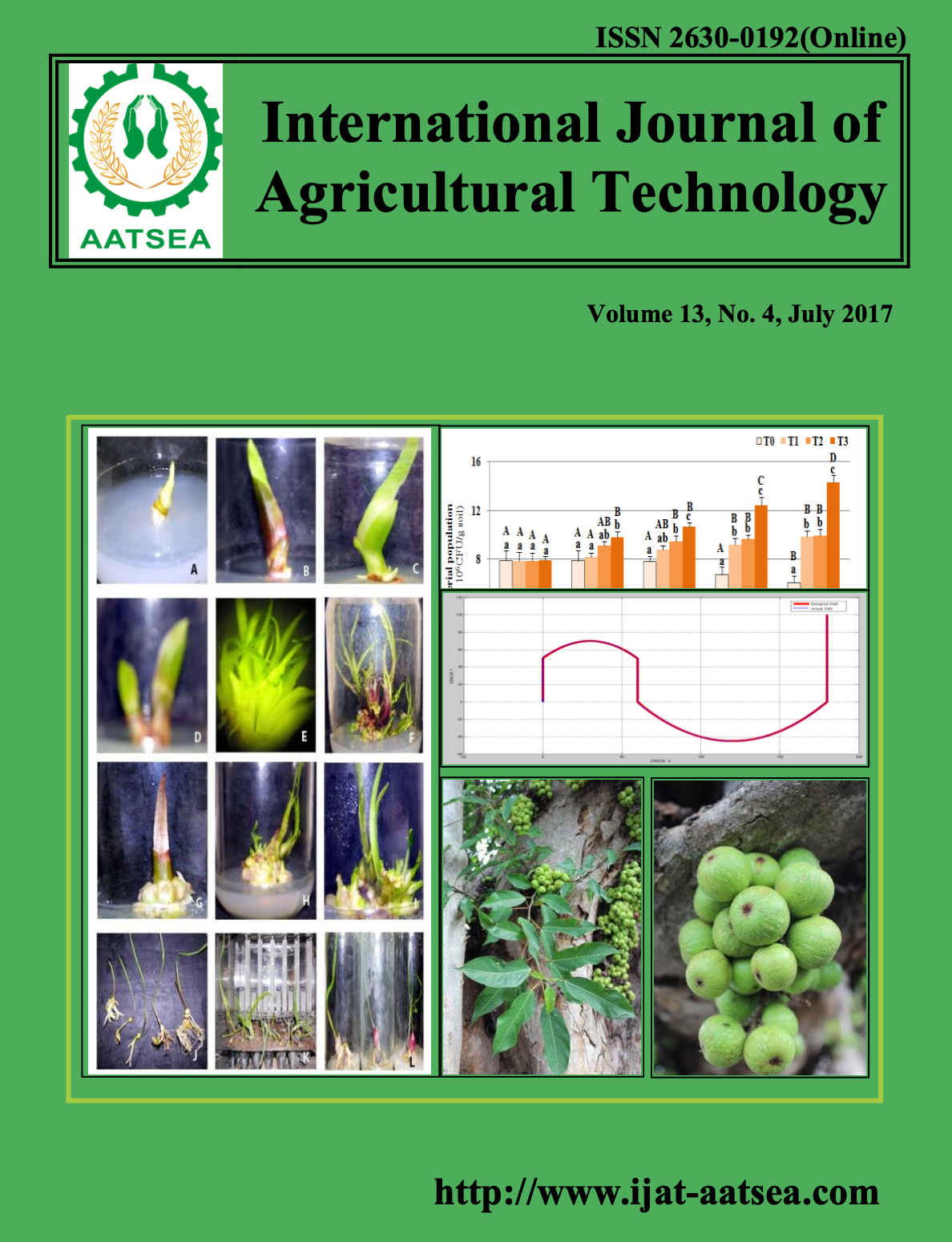Evaluation of crude extract substances from Streptomyces spp. for controlling Colletotrichum gloeosporioides caused anthracnose of chili
Main Article Content
Abstract
Anthracnose of chili caused by Colletotrichum gloeosporioides, is a major problem among important economic crops. In the present study, 34 isolates of Streptomyces spp. were used to determine the inhibition of C. gloeosporioides growth using dual culture test. The results showed 19 isolates of Streptomyces spp. had the percent inhibition of C. gloeosporioides growth and the highest percent inhibition of radial growth was Streptomyces isolate CH15. In addition, the percent inhibition of radial growth was Streptomyces isolate CH15 was not significantly different from 0.75 mg/ml benomyl. Then, the ethyl acetate extract of Streptomyces isolate CH15 at concentration 87.7 mg/ml in 5% (V/V) DMSO was tested for inhibiting C. gloeosporioides by the disc diffusion method. The results showed that the efficiency of the ethyl acetate extract of isolate CH15 for controlling C. gloeosporioides was not significantly different from 0.75 mg/mL benomyl.
Article Details

This work is licensed under a Creative Commons Attribution-NonCommercial-NoDerivatives 4.0 International License.
References
Bibb, M. (1996). The regulation of antibiotic production in Streptomyces coelicolor A3(2). Microbiobgy 142: 1335-1344.
Bosland, P. W. and Votava, E. J. (2000). Peppers: Vegetable and Spice Capsicums. Crop Production Science in Horticulture Series No. 12. CABI Publishing, United Kingdom.
Boukaew, S., Plubrukam, A. and Prasertsan, P. (2013). Effect of volatile substances from Streptomyces philanthi RM-1-138 on growth of Rhizoctonia solani on rice leaf. BioControl 58: 471-482.
Fguira, L. F. B. and Mellouli L. (2012). Isolation and screening of Streptomyces from soil of Tunisian oases ecosystem for nonpolyenic antifungal metabolites. African Journal of Biotechnology 11:7512-7519.
Islam, Md. R., Jeong, Y. T., Ryu, Y. T., Song, C. H. and Lee, Y. S. (2009). Isolation, identification and optimal culture conditions of Streptomyces albidoflavus C247 producing antifungal agents against Rhizoctonia solani AG2-2. Mycobiology 37:114-120.
Khattab, A. I., Eltahir, H. B. and Humodi, A. S. (2016). Streptomyces: isolation, optimization of culture conditions and extraction of secondary metabolites. International Current Pharmaceutical Journal 5:27-32.
Kim, Y. S., Lee, I. K. and Yuncorresponding, B. S. (2015). Antagonistic effect of Streptomyces sp. BS062 against Botrytis Diseases. Mycobiology 43:339-342.
Kumar, P. S., Duraipandiyan, V. and Ignacimuthu, S. (2014). Isolation, screening and partial purification of antimicrobial antibiotics from soil Streptomyces sp. SCA 7. Journal of Medical Sciences 30:435-446.
Kusama, S., Kusakabe, I. and Murami, K. (1986). Purification and some properties of J-l,3-glucanase from Streptomyces sp. Agricultural and Biological Chemistry 50:1101-1106.
Milerue, N., Chunwongse, J., Struss, D. and Waseed, S. (2016). Variation of small erect-fruited chili in Thailand. Agriculture and Natural Resources 50:43-47.
Moe Oo, M. and Oh, S. K. (2016). Chili anthracnose (Colletotrichum spp.) disease and its management approach. Korean Journal of Agricultural Science 43:153-162.
Moenne-Loccoz, Y., Tichy, H., O’Donnel, A., Simon, R. and O’Gara, F. (2001). Impact of 2,4-Diacetyl phloroglucinol producing biocontrol strain Pseudomonas fluorescens F113 on intraspecific diversity of resident cultivable fluorescent Pseudomonads associated with the roots of field-grown sugar beet seedlings. Applied and Environmental Microbiology 67:3418-3425.
Nguyen, X. H., Naing, K. W. Lee, Y. S., Kim, Y. H., Moon, J. H. and Kim, K. Y. (2015). Antagonism of antifungal metabolites from Streptomyces griseus H7602 against Phytophthora capsici. Journal of Basic Microbiology 55:45-53.
Palaniyandi, S. A., Palaniyandi, S. H., Yang, J. H., Cheng, L. M. and Suh, J. W. (2011). Biological control of anthracnose (Colletotrichum gloeosporioides) in yam by Streptomyces sp. MJM5763. Journal of Applied Microbiology 111:443-455.
Pakdeevaraporn P., Wasee, S., Taylor, P. W. J. and Mongkolporn, O. (2005). Inheritance of resistance to anthracnose caused by Colletotrichum capsici in Capsicum. Plant Breeding 124:206-208.
Schrenk, H. and Spaulding, P. (1903). The bitter rot of apples. Science New York 17:750-751.
Wang, L., Xing, M., Di, R. and Luo, Y. (2015). Isolation, identification and antifungal activities of Streptomyces aureoverticillatus HN6. Plant Pathology and Microbiology 6:281-285.


